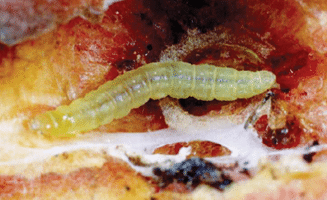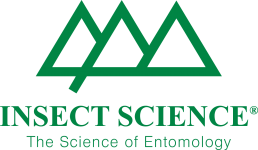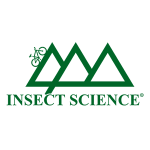Host plants
The primary hosts are peach and nectarine. Secondary hosts include plum (mainly shoots), pear, apple, and almond. In other countries it has also been recorded on quince, apricot and cherry. Infestation of secondary hosts will be more prevalent when in close proximity to peach and nectarine orchards. In other countries the primary host varies; in Japan it is sand pear (nashi), in Argentina and Brazil, apple, and in California flowering quince. In Italy there has been an increase in OFM infestation in apple, suggesting that is has the potential to become an important apple pest.
Damage
The larvae tunnel into the succulent growth tips of shoots or into the fruit. Larvae of the first two generations (in spring) tend to infest the young shoots, while in summer they feed on shoots and fruit. Under high populations levels, immature fruit may also be infested. Larval tunnelling into shoot tips causes wilting and die-back above the entry point, referred to as “strikes” or “flagged shoots”. Brownish frass (larval excreta) can be seen on the surface at the entrance or exit holes. Such shoot die-back stimulates multiple lateral shoot development, causing “bushing” of the tree, which in nursery or new, non-bearing orchards adversely affects the future shape of the tree.
Economic damage occurs when larvae tunnel into the fruit; they may either chew meandering tunnels in the fruit, or feed superficially on the fruit, particularly when it is still green. Larvae can enter the fruit anywhere on the surface but usually it is near the stem-end or where two or more fruit touch. In apples, the entrance and surface damage looks similar to that of codling moth. However, OFM tunnels in apples follow a more aimless, meandering course in the fruit, and unlike codling moth, the larvae do not usually feed on the seeds.
Oriental fruit moth is a key pest of peach and nectarine, particular in cultivars harvested after December. Without adequate control it can virtually destroy an entire crop. Although effective control can be achieved with pheromone-based mating disruption, and with diligent use of certain insecticides, the sometimes serious infestation of apple fruit reported from other countries is of concern. A decrease in insecticide usage for codling moth in South African apple orchards may in time lead to an increase in the incidence of OFM in apple.
Life history
The life history of oriental fruit moth closely resembles that of codling moth, being synchronized with that of its primary host plant. Moths of the overwintering generation generally start to emerge from their cocoons in early August to April, and depending on climatic conditions, there are four to six flights (generations) per season.
Moths start to mate within 1-2 days of emergence. Mating takes place from a few hours to about an hour before sunset. Most females mate once although multiple matings can occur later in the season when populations are high. Males usually mate only once in a 24-hour period, but can mate with up to five different females on successive nights. Eggs are laid singly or in groups of two to three on the upper surfaces of leaves, on young developing twigs and on smooth-skinned fruit; seldom are eggs laid on the pubescent surface of peaches. Each female moth can produce up to 200 eggs.
Larvae from the first two flights feed mainly in the rapidly growing terminal shoot, while larvae of the summer flights feed mainly on fruits and shoots. Fruit infested early in the season that do not drop have clearly visible entrance holes, with a gummy frass exuding from them, while larvae attacking nearly ripe peaches usually enter the fruit near the stem, leaving a very small and inconspicuous entrance hole. There are 45 instars depending on temperature and host material. Mature larvae spin in cocoons under bark, in cracks on tree trunks, in old pruning wounds, in depressions on the fruit surface, and in the stalk end of the fruit.
The mean duration of the egg, larval and pupal stages varies considerably between spring and summer: eggs, 3-6 days; larvae 13-21 days; and pupae 11-14 days. The spring generation lasts about 70-80 days and a summer generation approximately 30 days.
Natural enemies
Eggs parasitized by an unidentified parasitic wasp suspected to be Trichogrammatoidea lutea Girault (Trichogrammatidea) have been observed and unidentified parasitoids have been reared from the larvae. Little else is known about the natural enemy complex of OFM in South Africa.
More than 100 species of parasitoids have been reported to attack OFM, although parasitism plays a major role in OFM control in commercial orchards because of the sensitivity of many parasitoids to commonly used insecticides. Only about half a dozen species account for 80% of the parasitism. These include the braconid wasp, Macrocentrus ancylivora Rohwer (USA), and ichneumon wasp, Glabridorsum stokesii (Cameron) (Australia), and a Trichogramma sp. (Australia). Other natural enemies include chalcidoid wasps, tachinid flies, carabid beetle, earwigs, and the entomopathogenic nematodes Steinernema and Heterorhabditis spp. Spiders also eat moth eggs, moths and larvae.
Management
Oriental fruit moth is difficult to control because it has several generations during the growing season (4-6 in South Africa), and it has developed resistance to a number of insecticides. Like codling moth, it is a pest with a low treatment threshold. Monitoring systems are strongly recommended. When control programmes are based on only insecticides, pheromone traps should be used for monitoring. However, when control is by mating disruption, pheromone traps cannot be used as the lures used in traps contain the same pheromone that is released from mating disruption dispensers, and males therefore find it difficult to locate the pheromone traps. Therefore, in mating disruption orchards, pheromone traps should be used together with so-called bait traps containing terpinyl acetate. This chemical is attractive to the moths (and to many other insects). Shoot and fruit inspections can also give valuable information on OFM population levels in mating disruption orchards.
The moth has a long period of activity which extends over a period of nine months. Where control in orchards is based solely on insecticides, the target of the spray applications is the newly-emerged larvae before they enter the shoot tips or fruit. Sprays need to be applied every 14 days, but this is costly and has a detrimental impact on the orchard ecosystem, particularly for late cultivars. The number of sprays can be halved, and the sprays better timed, by using a day-degree phenology model, as with codling moth. This model predicts key events in the pest’s developmental cycle according to accumulated orchard temperature units over time. When using only insecticides, it is also important to monitor the activities of this pest after harvest. Necessary sprays should be applied according to the phenology model.
Although control of OFM can be achieved with insecticides alone, this approach is not considered sustainable. Mating disruption in combination with selected and limited insecticide use has led to a major reduction in reliance on insecticides for the control of this pest. In mating disruption orchards, dispensers containing the female sex pheromone are hung in the top third of the tree canopy before the moths emerge in spring, at densities of 250-1000 per ha depending in the product used and population levels. The high concentration of pheromone prevents or disrupts communication between the sexes and prevents or delays mating. Other mating disruption technologies include pheromone formulations than can be applied by conventional spray rigs and pheromone release systems. Mating disruption has proved to be an excellent control option when applied as an area-wide treatment, in which case supplementary insecticide treatments are seldom required.






